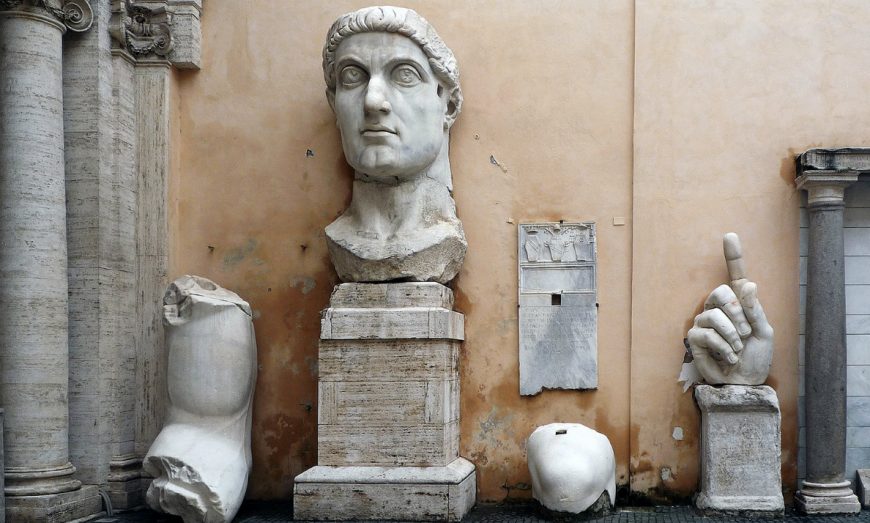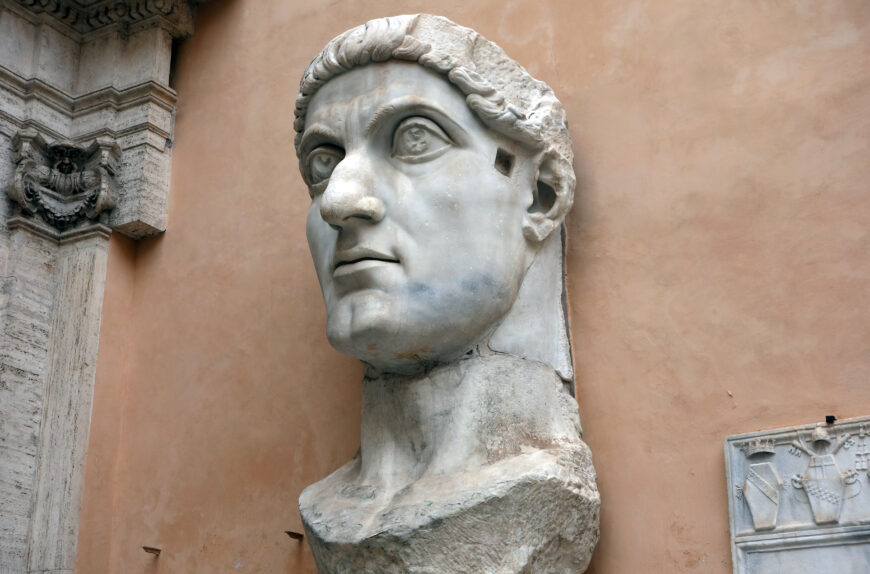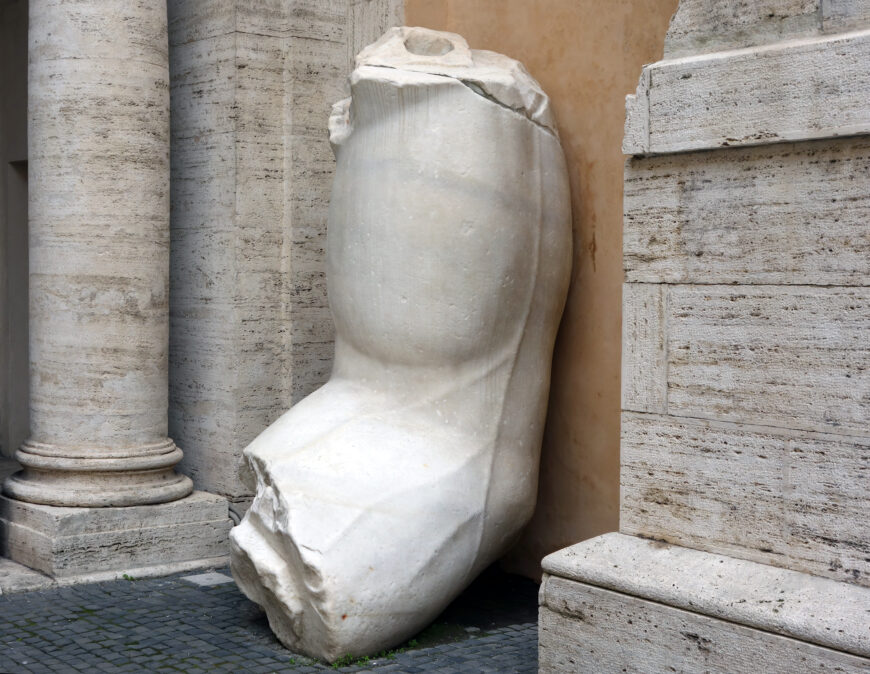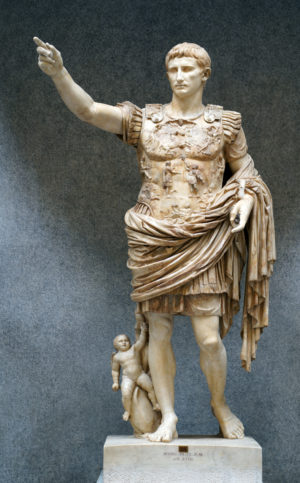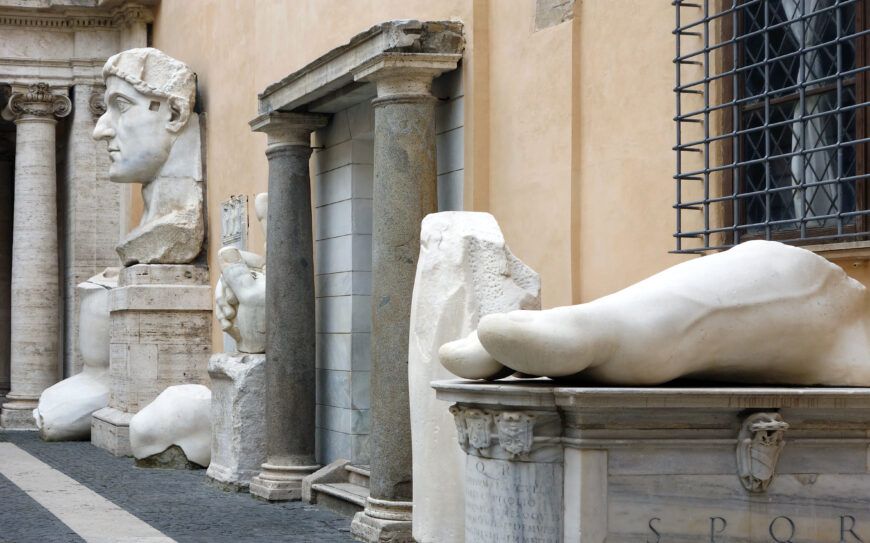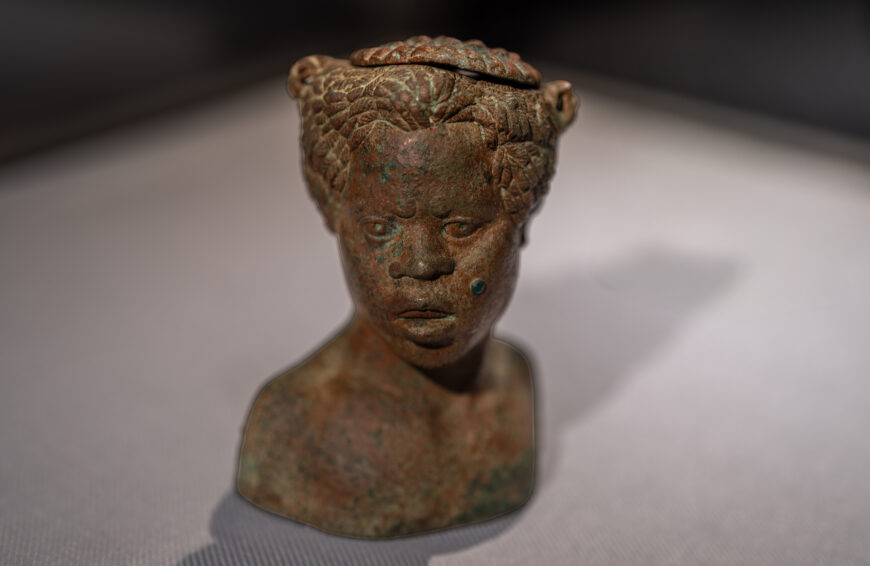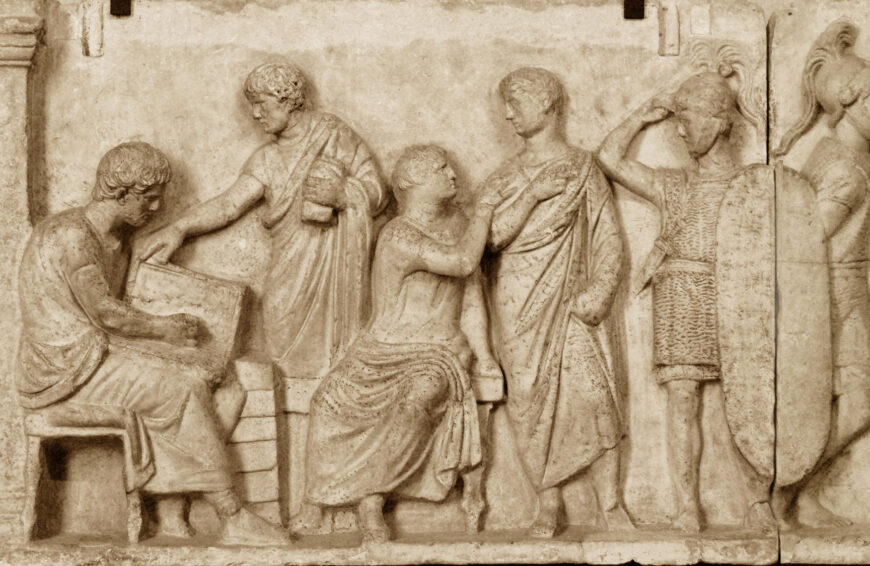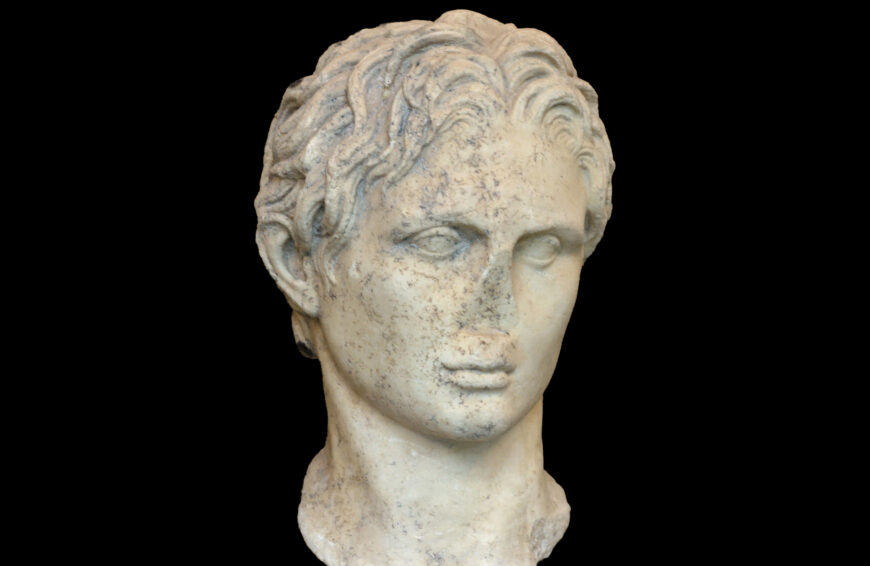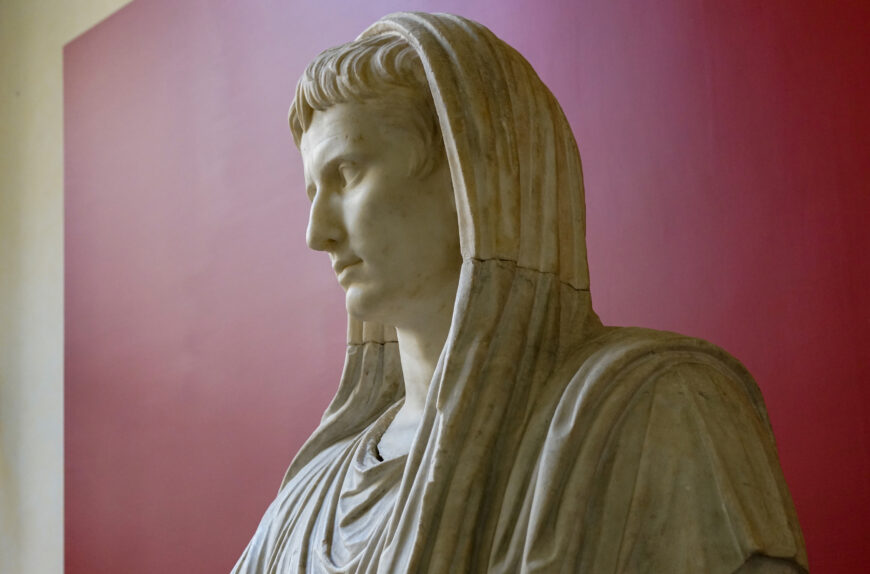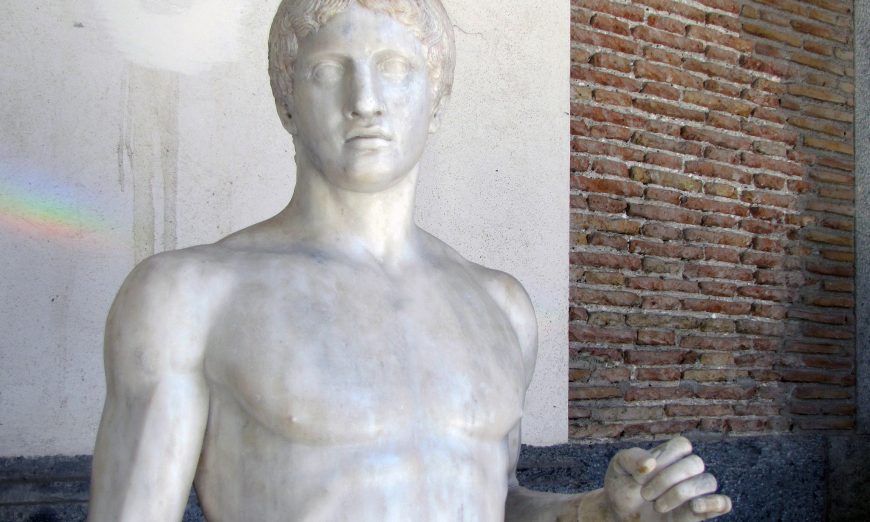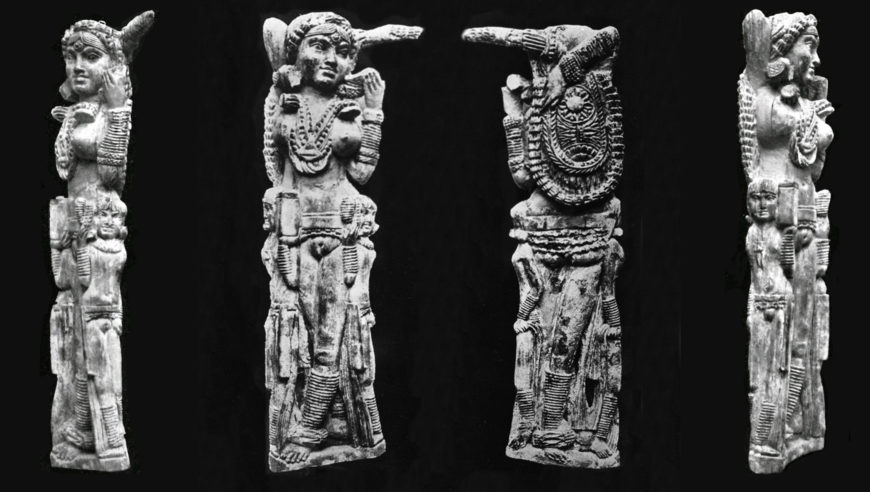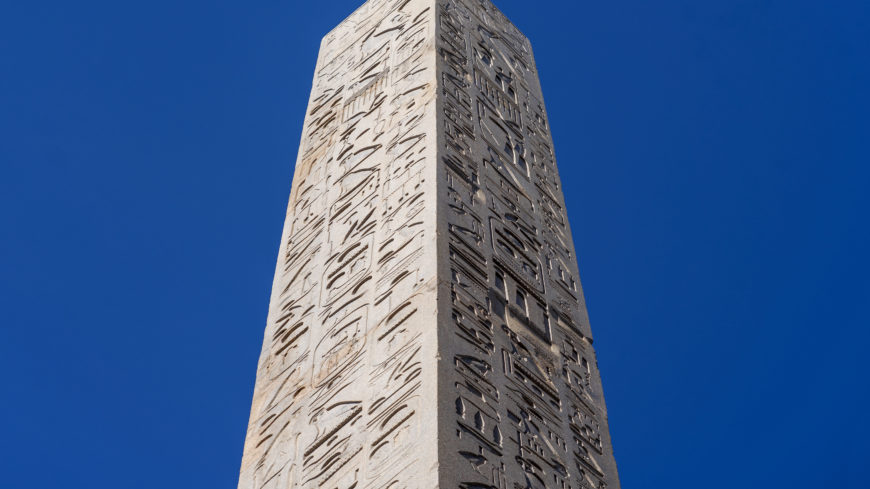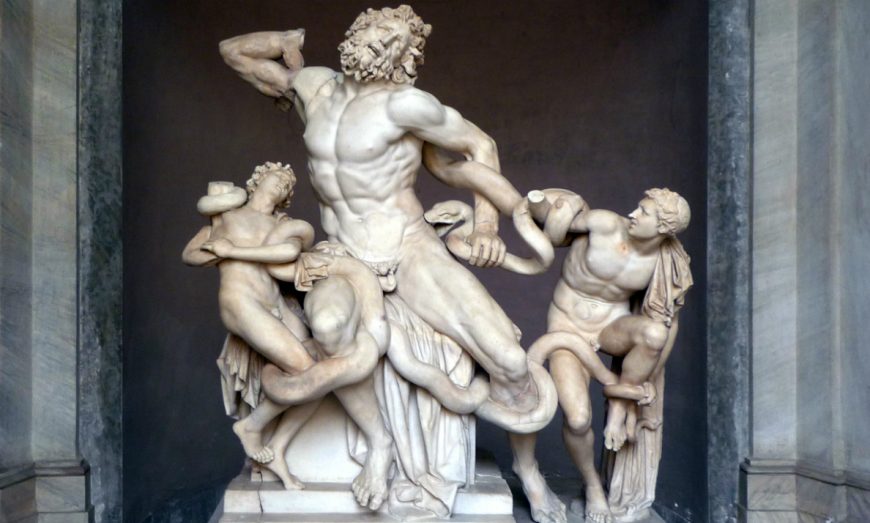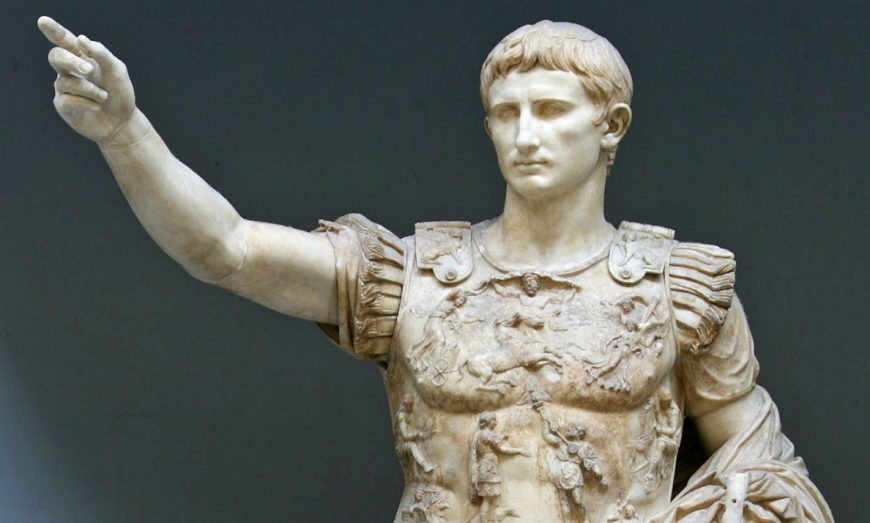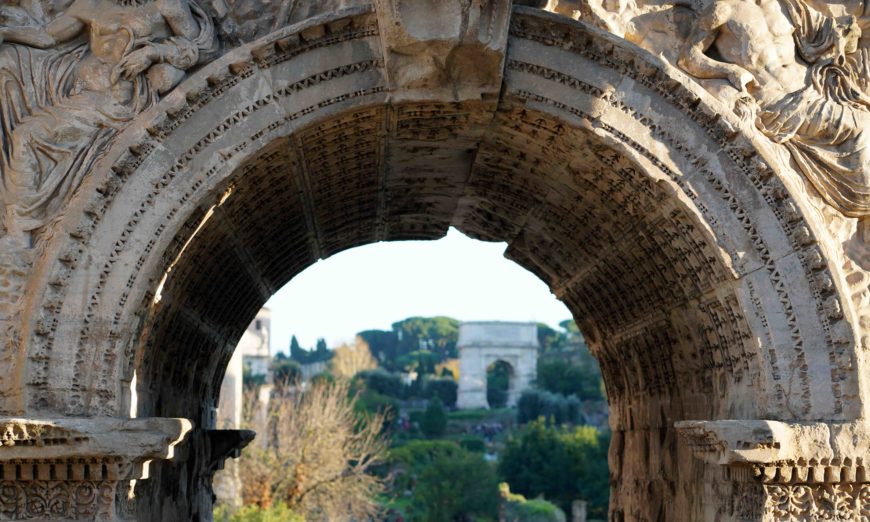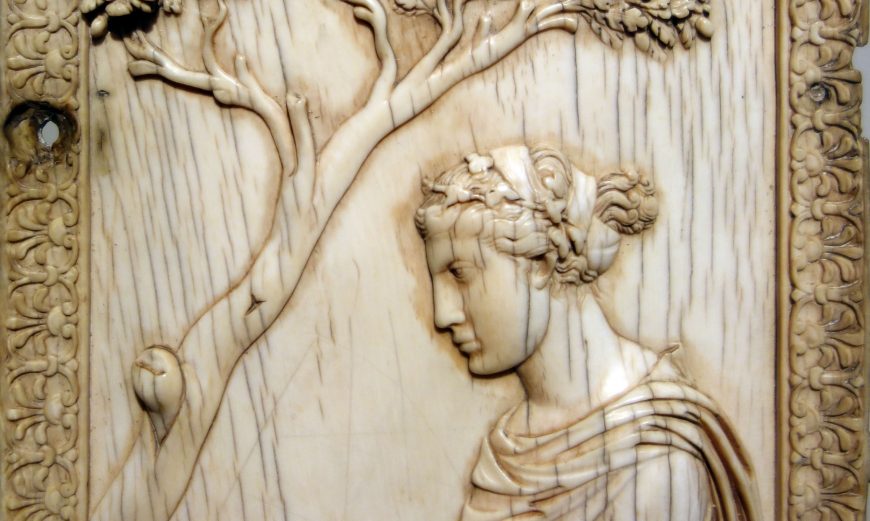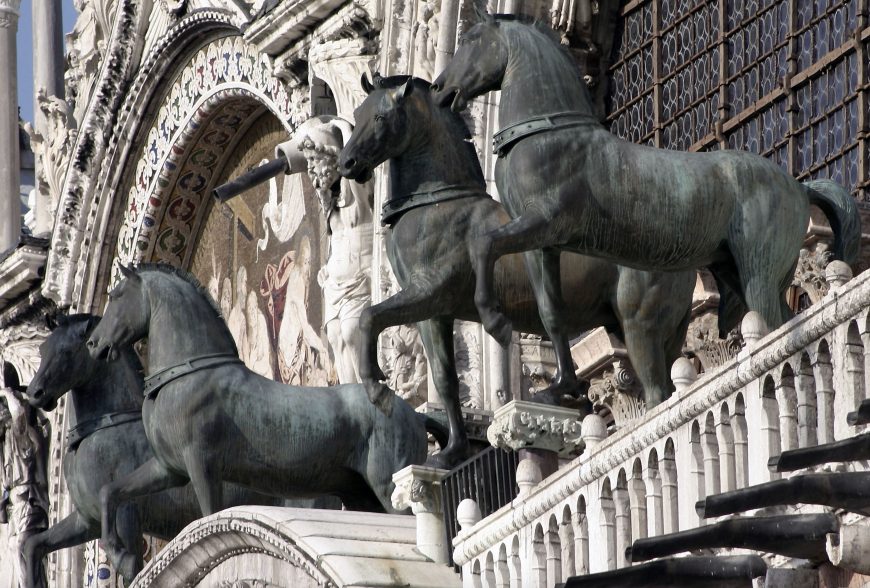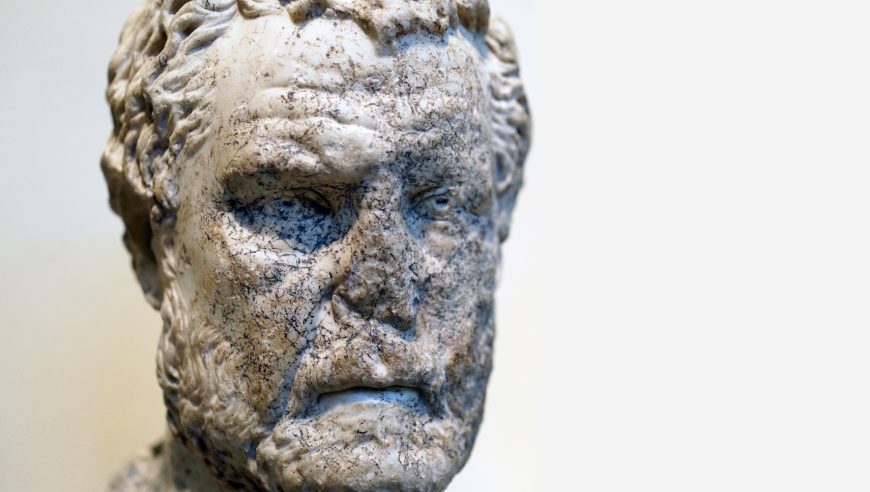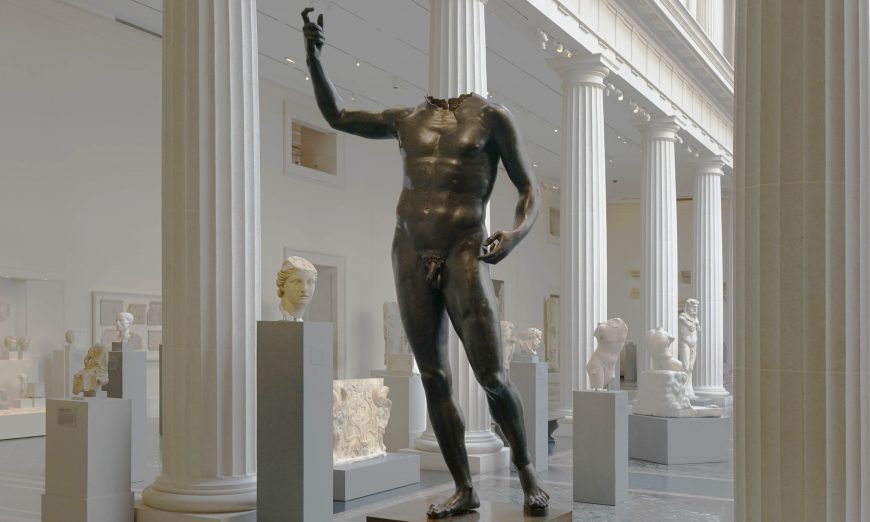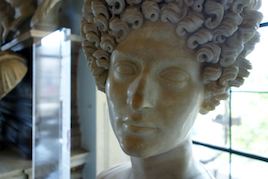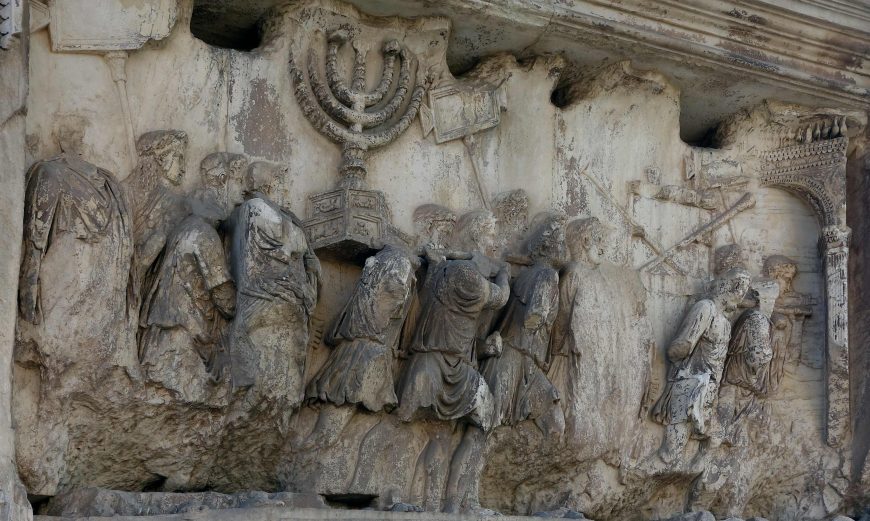Does the abstraction of form and faraway look in this colossal portrait hint at the growth of Christianity in Rome?
Colossus of Constantine, c. 312–15 C.E. (Palazzo dei Conservatori, Musei Capitolini, Rome)
[0:00] [music]
Dr. Steven Zucker: [0:05] Well, there’s the head.
Dr. Beth Harris: [0:08] And elbow.
Dr. Zucker: [0:09] I see a knee and a finger pointing up.
Dr. Harris: [0:12] And a shin.
Dr. Zucker: [0:13] And a foot.
Dr. Harris: [0:15] And another foot.
Dr. Zucker: [0:16] We’re looking at the remains of a colossal marble representation of the Emperor Constantine.
Dr. Harris: [0:22] This colossal sculpture was originally, we think, about 40 feet high. So, really big.
Dr. Zucker: [0:28] It would have filled this extraordinary space at the end of the Basilica of Maxentius and Constantine.
Dr. Harris: [0:35] This was a very large public space right here on the Forum. At the end of it was a rounded area, a niche. The sculpture was found there, so we think it was meant for that space.
Dr. Zucker: [0:48] Michelangelo is the one who actually brought it up to the Capitoline Hill, which was the ancient government center. Constantine is certainly a Roman emperor, but he’s the last pagan Roman emperor and the person who really ushers in Christianity and all the changes that will take place in Italy and in the former empire.
Dr. Harris: [1:06] He moves the capital of the empire to Constantinople, the city of Constantine, all the way in the East, and in a way begins the decline of the city of Rome that we see happen in the Middle Ages.
Dr. Zucker: [1:19] Maybe it’s not so inappropriate that we see him in fragments in this city.
Dr. Harris: [1:23] Maybe not. I find this portrait so interesting. We think his body had a core of wood and mud brick, and maybe was covered in gilded bronze. We’re not really sure. I find him so different-looking than other images of emperors.
Dr. Zucker: [1:39] This is a really interesting stylistic moment. When we think about ancient Greece and ancient Rome, I think most people just think of the high classical moment and all of its naturalism. We’re talking about a long period of time in the classical era, and styles change there also.
Dr. Harris: [1:55] If you think about the history of Roman emperors and their images, you often see a combination of realism and idealism, so that the citizens of the Roman Empire could identify that particular emperor. We know what Hadrian looked like, or Trajan looked like, or Vespasian looked like.
Dr. Zucker: [2:12] Right. There has to be enough specificity so you can say, “Ah, that’s my emperor.”
Dr. Harris: [2:16] Exactly. But at the same time, they were idealized to greater or lesser extents and thereby recalled ancient Greek sculpture. By idealizing them, they were made to seem divine or godlike. But here, Constantine doesn’t look like either of those traditions to me.
Dr. Zucker: [2:33] Well, this was a moment of real transition. It’s not the issue between a kind of really high-pitched naturalism that can capture the characteristics of an individual’s face and a kind of idealism. This is a kind of abstraction of the human body.
Dr. Harris: [2:47] There’s something abstracted, I think, about the oval shapes of his eyes, where we have a sense of them being reduced to geometric shapes, the way that his eyebrows form these semicircles around the ovals of his eyes.
[3:02] There’s something that looks geometric about not only his face but his hair. Maybe this is a sign of moving toward that symbolic way of representing that we see with the beginnings of Christianity.
Dr. Zucker: [3:16] I think it’s impossible to untangle it from the rise of Christianity, because of our subsequent knowledge of what will happen. I think we perhaps don’t know enough about the subtle shifts in Roman style, but my understanding is that there was also different kinds of representation for different strata of society; that one could recall the imperial past, one could recall the more intellectual pursuits of the Greeks through a kind of naturalism, but one might speak to the here and the now and the broader population through a greater degree of abstraction.
Dr. Harris: [3:55] Through figures that look to us as disproportionate, maybe stocky, and stiff in their movements, without the lovely contrapposto that we see in ancient Greek and Roman art. He seems to be looking beyond us and not really in the here and now. Maybe in that way too there’s some suggestion of the Christian and the heavenly.
Dr. Zucker: [4:18] Well, certainly of his divinity.
[4:20] [music]
Arranged across the courtyard of the Palazzo dei Conservatori (the building that houses one part of the Capitoline Museums) in Rome is an array of monumental body parts. This isn’t a crime scene, but the display context for one of the most important sculptures of the ancient Roman world—the Colossus of Constantine.
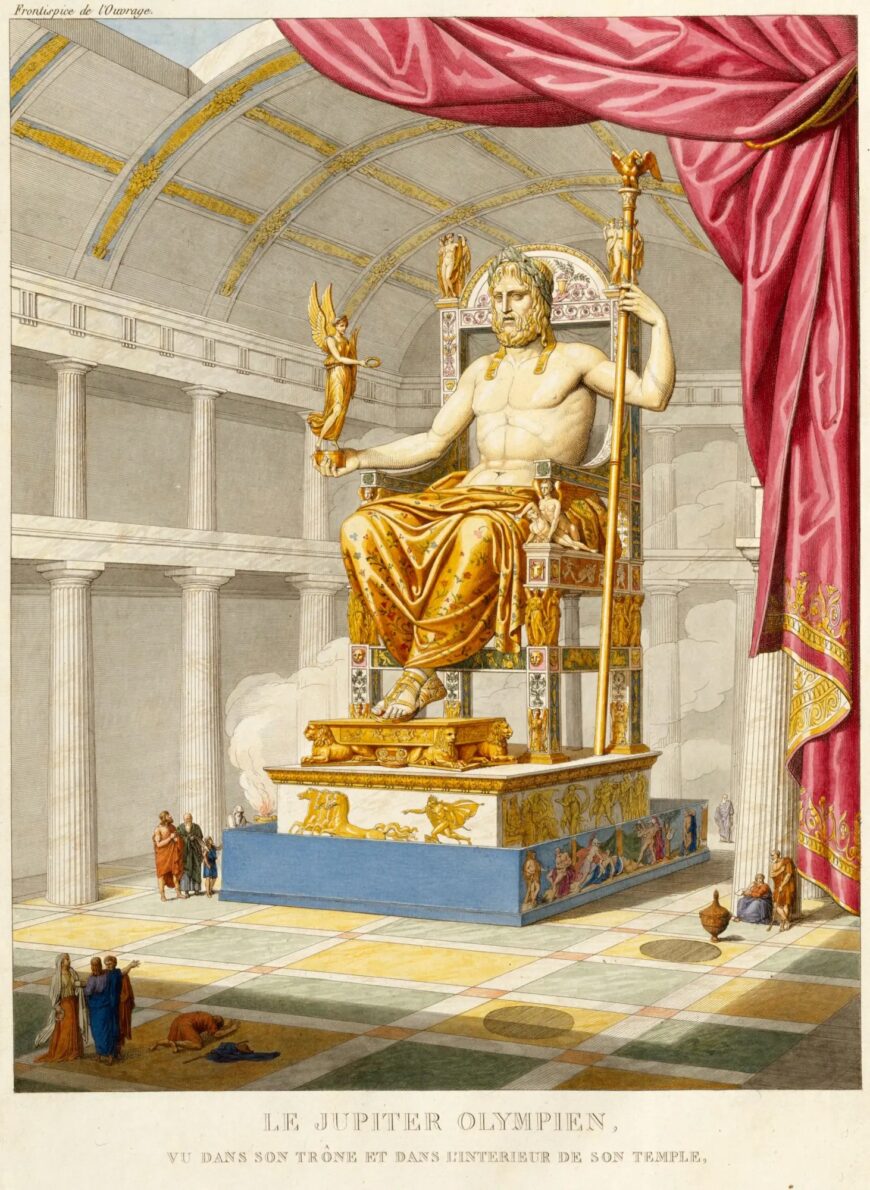
Reconstruction of Zeus at Olympia, frontispiece for A.-C. Quatremère de Quincy, Le Jupiter Olympien… (Royal Academy of Arts, London)
The Colossus of Constantine is, well, colossal. The head alone is over eight feet (approx. 2.5 meters) tall and the statue would have measured over 40 feet (12 meters) in height. In its original form, the statue represented the Emperor Constantine seated on an imperial throne, with his right arm raised and pointing towards the sky.
The format for this statue originated with the 4th century B.C.E. chryselephantine statue of Zeus at Olympia, by the famed Greek Classical sculptor Phidias. Later, it was widely used as a statue formula for representations of Jupiter in the Roman world (as on the coin below). In terms of today’s material culture, the pose is very similar to the seated statue of Abraham Lincoln in Washington, D.C. though Constantine measured twenty feet taller than Lincoln!
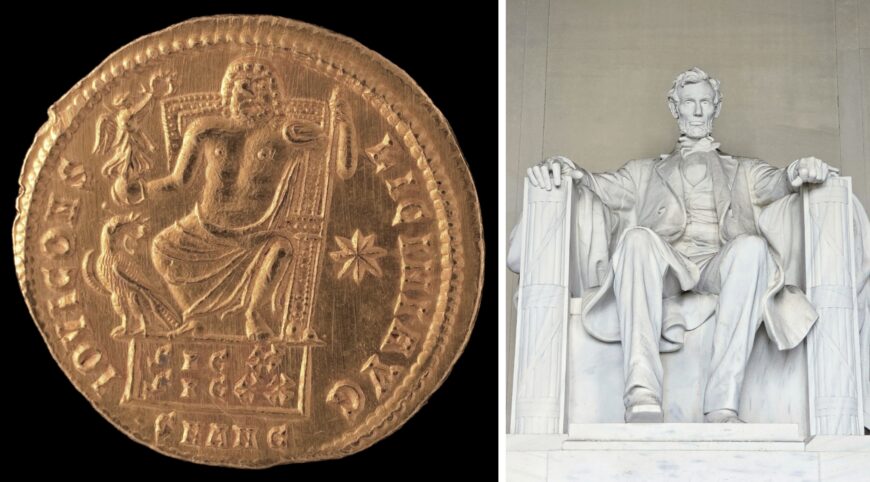
Left: Jupiter on a Gold Aureus of Licinius, 308–24 C.E. (Roman) (Lawrence University & Buerger Coin Collection, Appleton); right: Daniel Chester French, Abraham Lincoln, 1920 (Lincoln Memorial, Washington, D.C.)
The extant remains of the Colossus of Constantine are white marble fragments of the limbs and head of the once-complete statue. The head, itself, is a wonder to behold. The monolithic block presents the viewer with a larger-than-life image of the emperor Constantine (also known as Constantine I, and Constantine the Great), who ruled the Roman Empire from 306–337 C.E. His visage is flawless with smooth cheeks and large deep-set eyes. The pupils of the eyes are carved in a distinctive heart-shaped form which was characteristic of Roman portraits in the Late Empire.
On his temples, we see square dowel holes that, along with the row of drill marks along the front of his coiffure, suggest the presence of a now-lost laurel wreath, or perhaps a bronze crown. The head is not carved in on all sides. Though freestanding, the head of the Colossus of Constantine was left uncarved at the back. In fact, the back of the head is so flat it suggests the statue was originally situated up against a wall.
The remaining limbs—two feet, a kneecap, a bicep, and a chest fragment—make up the rest of the assemblage. The arm is rendered in shocking naturalism. The musculature of the arm is pronounced—with veins bulging beneath the surface of the skin. The feet are also very naturalistic in detail, with the nail beds on the toes delicately carved and molded. Furthermore, the left foot is carved so as to appear as if the heel is rising off the ground. This indicates that the original sculpture, though seated, had a dynamism and a sense of movement.
There are two sculpted right hands associated with this statue. Many scholars suggest that a second hand was crafted later in order to create a vehicle for Christian iconography and replace an earlier hand that held a purely imperial symbol.
Even in his present state of disassembly, his vacant stare passes above and beyond the head of the viewer, underscoring his power. He cannot be troubled by earthly concerns. The portrait features of Constantine are idealized to the point of abstraction, with not a hair in his cap-like head of hair out of place.
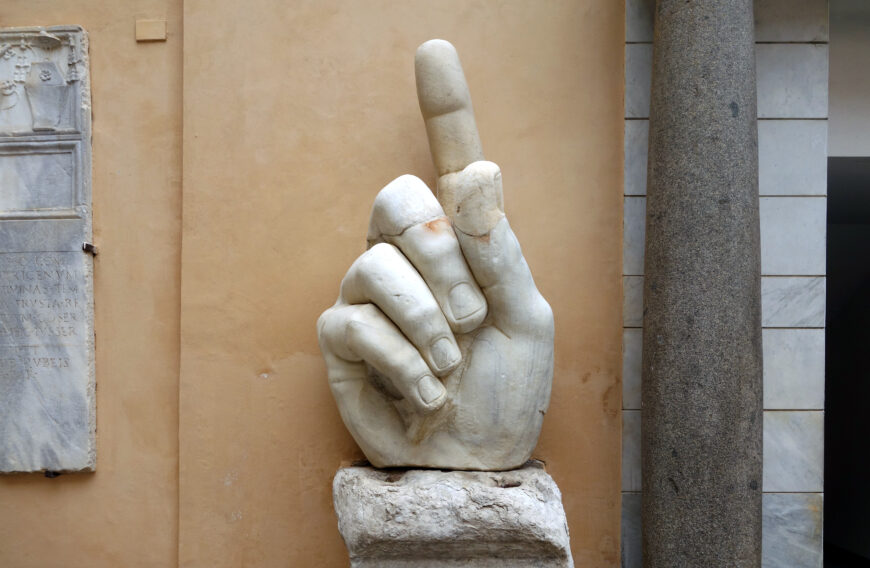
Right hand, Colossus of Constantine, c. 312–15 C.E. (Palazzo dei Conservatori, Musei Capitolini, Rome)
The right hand of Constantine originally held a bronze object that would likely have been offset at an angle, as suggested by the remaining dowel holes. The form of this object is often debated, was it a scepter? A cross? Some combination of the two? Additionally, the index finger of the right hand is pointing skyward, creating a link between the ruler himself, and the realm beyond. This connection is important. In earlier statues of Zeus or Jupiter this gesture would have referenced the location of Mount Olympus. But here, the meaning is more obscure. Constantine was famously the first Christian Roman emperor, does this gesture perhaps reference the heavenly realm of Christianity?
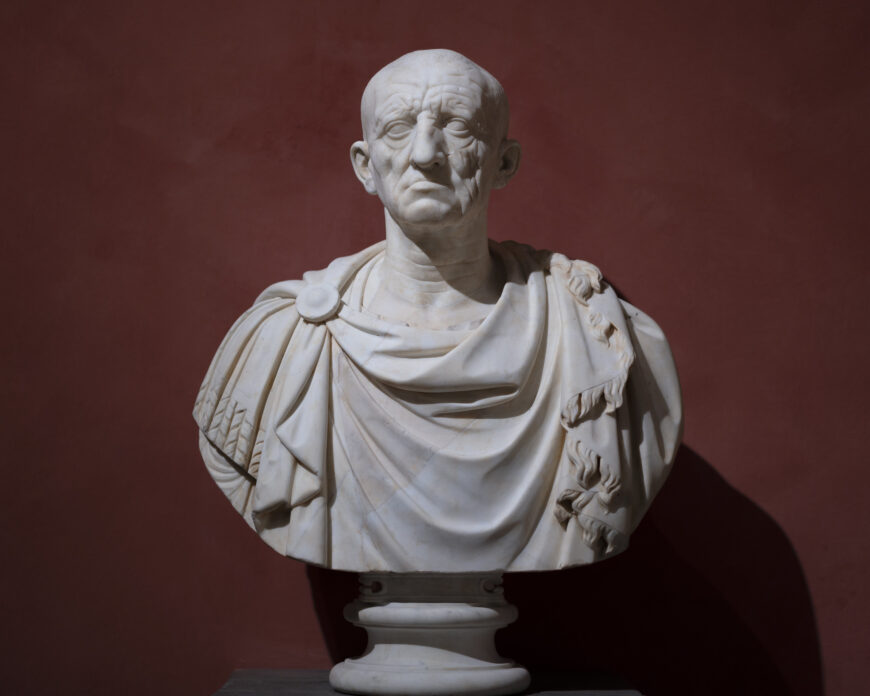
Head of a Roman Patrician from Otricoli (Republican period), c. 75–50 B.C.E., marble (Palazzo Torlonia, Rome; photo: Steven Zucker, CC BY-NC-SA 2.0)
What’s in a face?
Since the Republican period, portraits were a major element of Roman material culture. For the Romans, a portrait statue expressed status, preserved memory, and celebrated the glory of the individual. Portrait sculptures took the form of either busts or full-length statues and were made from a variety of materials, including marble, terracotta, and bronze. Beginning in the Roman Republican period, portraits became an important political tool. Images of powerful men, and even women, were included in collections displayed in both family homes and public settings.
When Augustus, the first emperor of Rome, came to power in 27 B.C.E., the imperial portrait statue underwent a powerful upgrade. With a production now overseen largely by the state, images of the emperor and his family became abundant. Adorning fora, freestanding arches, theaters, and palaces—portrait statues were used to advertise imperial power and disseminate a recognizable image of the ruler and his entourage throughout the far reaches of the empire. Each succeeding emperor, with the exception of a relative few, undertook considerable effort to produce an extensive material record of his reign, and his likeness.
Constantine was no exception. His material record is significant, with many of his most famous public works appropriated from those of earlier emperors. The Arch of Constantine, which famously employs spolia from earlier imperial monuments, integrates portraits of Constantine into traditional images through the reworking of preexisting portraits. This tendency of Constantine to rework pre-existing material culture to his own ends is typical of Late Imperial Roman art, and provides evidence that suggests the Colossus of Constantine had a previous identity.
The image of Constantine presented here shows a ruler who is larger-than-life. His commanding physical presence dwarfs the viewer and asserts authority, while the colossal scale suggests a link to the gods. Though recognizable as a distinct image of Constantine, elements of the visage are intentionally modeled to recall those of earlier emperors. Quoting the past was a way for later emperors to legitimize their rule in the present. Here, Constantine’s beardless face recalls that of Augustus and the Julio-Claudians, while his hair is modeled on that of the 2nd century C.E. emperor Trajan.
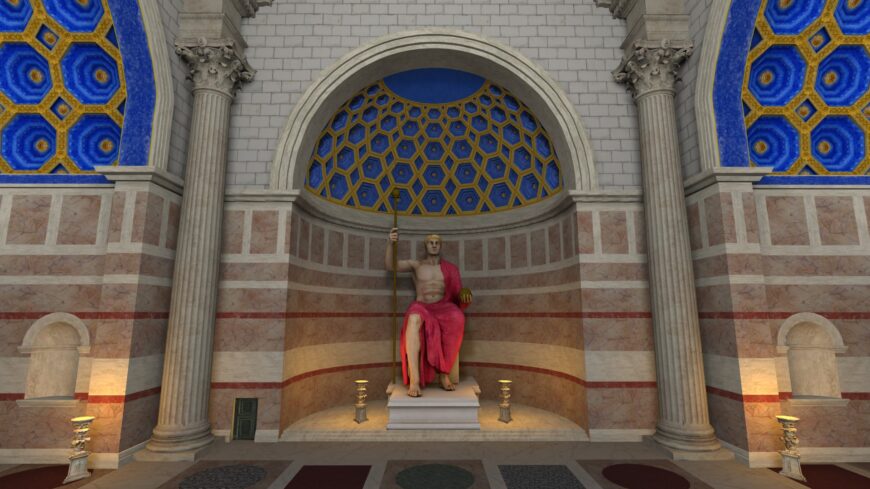
Rome Reborn, reconstruction of the Basilica of Nova (or Basilica of Maxentius and Constantine), Rome (Flyover Zone Productions)
Perfect provenance
The Colossus of Constantine was originally located in the west apse of the Basilica Nova (also known as the Basilica of Maxentius and Constantine) just down the hill along the Sacra Via. This was not a temple but rather a secular structure, used mainly for judicial proceedings. The basilica format, soon to be adopted as a preferred format for early Christian church architecture, was a longitudinal building in which a wide central aisle, known as a nave, flanked by smaller side aisles. Situating the statue at the curved end of the nave, known as an apse, presented Constantine as an imposing and god-like head of state.
We know exactly where the statue was located because the fragments were found in situ in the 15th century. During the Renaissance, men from all over Europe enthusiastically flocked to Rome to dig up the city in search of ancient remains. It is estimated that more damage was done to the ruins of Rome during the Renaissance than any other era. Wealthy men sought out fragments of the ancient empire to collect, study, and display in their grand houses and private collections. The head and marble limbs of the Colossus were uncovered in the ancient basilica in 1486 and moved to the Palazzo dei Conservatori courtyard on top of the Capitoline Hill by the artist Michelangelo. This is where they have remained for centuries.
The Colossus of Constantine is notable because it belongs exclusively to the material history of the city of Rome. The Basilica Nova was the known display context for the statue, and that is where it was found in the late 15th century. Its subsequent excavation, conservation, and display took place on the Capitoline Hill. Since its 4th-century inception, the Colossus of Constantine has always had a home in the eternal city. Unlike other notable works excavated during the early modern period, the Colossus of Constantine, though emulated by many, was never the target of looting campaigns—such as those of Napoleon that confiscated the Capitoline Brutus from the same museum. Constantine has always remained in Rome.
The many afterlives of Constantine
The legacy of Constantine has endured throughout the centuries. As the first Christian emperor of Rome his reign marked a transition point between the ancient and medieval worlds. In his afterlives, Constantine has been emulated by subsequent emperors—notably Charlemange and Napoleon I—studied by scholars from Late Antiquity through the present, and even canonized by the Eastern Orthodox Church.
The statue, as well, has had a significant journey since its role as a colossal imperial image. But, before we speak of the afterlife of the statue, we must first hypothesize about the previous lives of the stone. Recent conservation efforts on the white marble fragments have shown that the head was likely re-carved from an earlier statue. This was a common practice in the Roman empire, especially when an emperor experienced the damnatio memoriae or otherwise fell out of favor. As we have seen, during the Late Roman Empire, it was common to use and rework spolia in imperial building campaigns. This was likely due to increasing economic strife, and decreasing importance of the city of Rome. Constantine the Great employed an extensive amount of spolia in his public works, resituating and recarving images of those great emperors who came before him into his own image. It is also possible, due to the scale of this sculpture, that it was previously an image of a god, perhaps of Jupiter or Sol Invictus (the official sun god of the late Roman Empire). Whatever the original identity of the marble block, it has been preserved in perpetuity as a portrait of Constantine.
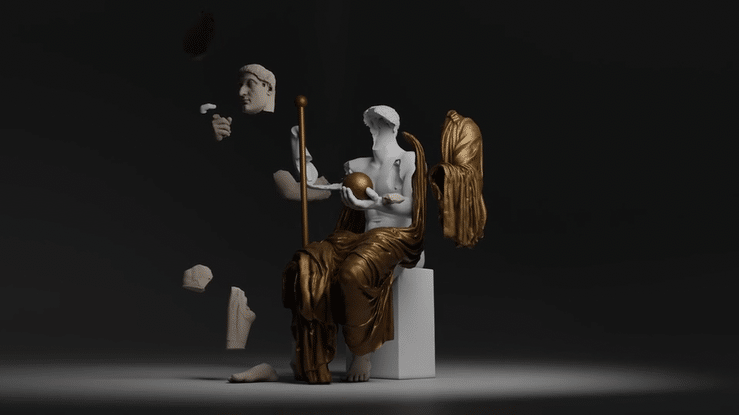
The 13-meter-tall (42 feet) work, displayed inside the Cisterna at the Fondazione Prada, is the result of months of close collaboration between the 3D team at Factum Foundation and a team of experts under the supervision of Claudio Parisi Presicce, the Capitoline Superintendent of Cultural Heritage
More recently, the Colossus of Constantine has had a new moment in the spotlight, ushering its presence into the 21st century. In a 2022 project to reproduce the original, a Madrid-based preservation non-profit, the Factum Foundation, created a 1:1 replica of the statue using resin, 3D printing, and other contemporary methods. First displayed in the 2022 exhibition “Recycling Beauty” at the Fondazione Prada (in Milan), the sculpture was installed in the gardens of Villa Caffarelli, adjacent to the Capitoline Museum where the original fragments are situated, in February of 2024. This reproduction is an imposing, and kitschy, addition to the museum landscape.
Though many aspects of the original Colossus of Constantine remain a mystery, the sheer scale is understood at least through the new reproduction. As a master of reproduction and reinterpretation himself, it behooves us to wonder how Constantine the Great would receive this 21st-century version of his imperial visage.


